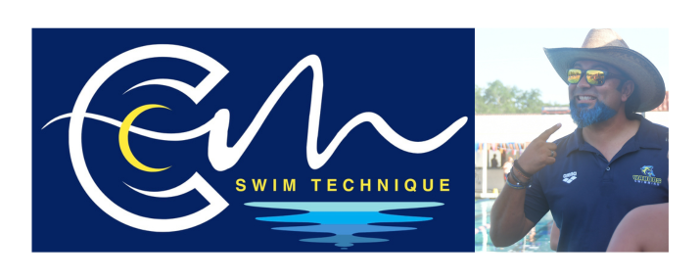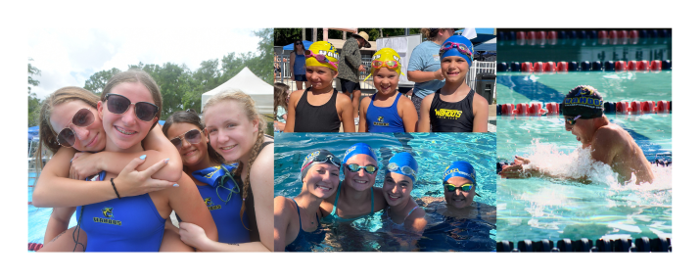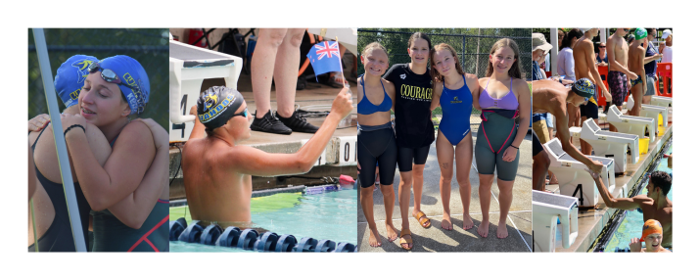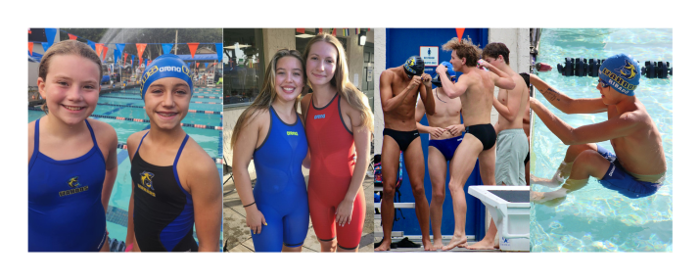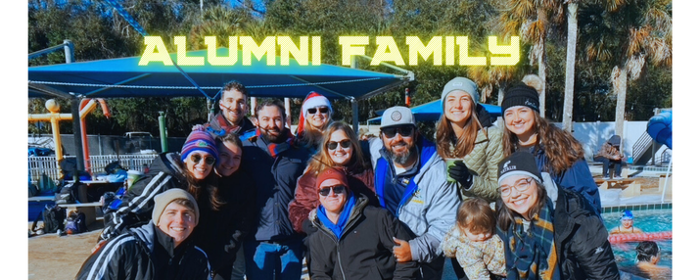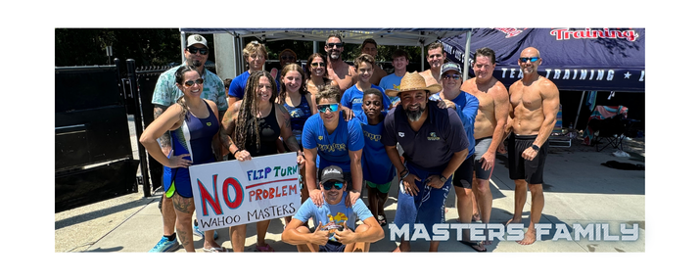Competitive & Recreational - FAQs
What are the expectations for year-round training?
Our goal is to help swimmers achieve and maintain their goals by being in the water on a more consistent basis. Swimming year-round encourages swimmers to set up short-term goals throughout the year and work toward achieving those goals. Like any other sport, consistency, repetition, and practice is key to success. Below is the minimum attendance recommendation per week per age group.
Recreational = 2 times per week
Juniors I = 3 times per week
Juniors II = 4 times per week
Advanced = 4-5 times per week
Elite & Premier = 6+ times per week
Can swimmers do other sports?
We currently have swimmers who participate in other sports. If the swimmer has great time-management skills, he/she can do other sports. There are great benefits with cross-training in multiple areas. However, please keep in mind that the athletes should swim the minimum recommendation for attendance so he/she can continue to improve in the sport throughout the season.
If the swimmer is in the Elite training group, improvement will be negligible if the swimmer only practices 3 times per week.
What can parents do to support the swimmers?
Parents can best support the swimmers by maintaining a positive environment in and around the sport, getting them to practice and meets on time, and enjoy watching them compete. Try not to be invasive and get caught up in their performances. Leave most of the swimming talk to the swimmer and the coach. If you ever have questions or concerns, please speak with the coaches.
Additionally, one of the best ways you can help is to get involved with the team! This includes volunteering at meets and helping to organize team activities. One thing our team (and city) desperately needs are USA Swimming Officials at swim meets. If you are interested in becoming an official, please contact the coaches for more information. This is a great way to learn more about swimming and get a front-row seat and get in on all of the action at the meets.
How can swimmers set goals?
Goal setting is essential to developing as a swimmer, and it is the best way to keep yourself accountable and on track throughout the season. To determine your goals, start by looking at what your current times are. Then, look at the Motivational Time Standards or the Time Standards for the championship swim meet appropriate for your age group. See what level you are currently on and then aim to try to move to the next. Set reasonable goals. Make sure you write down the steps that you will need to take to get there. This may require your attending more practices, improving technique, eating healthier, managing your time, etc.
What else can swimmers do to get faster and accomplish goals?
Always be sure to communicate openly with your coach about your goals. They will be your number one resource to hold you accountable. Communication, along with 100% practice attendance and effort is key to improvement. If you have questions or you are experiencing difficulties reaching your goals, never hesitate to reach out to your coach!
What if a swimmer wants a break from the sport?
Every athlete needs a break. It is no different from adults in the workforce. We all need a vacation so we can re-charge our batteries. The Wahoos of Jacksonville have set two weeks of time off in the year so athletes and parents can plan activities for the family. By syncing the breaks, athletes will not miss out on important weeks of the season.
Break # 1 = The last 2 Weeks of March. This break starts usually after Senior Champs which is the 2nd week of March.
Break # 2 = The first 2 Weeks in August. This break is after our Area 1-4 Championship which is at the end of July.
Our hope is that swimmers that are serious about training year-round try very hard to take this time off and focus on the training seasons.
What if a swimmer feels burned out?
Communication is key in these situations. Please reach out to the coach when this conversation is presented by your swimmer. Commitment and discipline are KEY to reach goals.
This is not just about swimming. It is about learning DISCIPLINE through the sport. By learning to stay committed and focused on their goals, athletes will learn greater life lessons.
LOCATIONS
Can we attend any location?
Yes, you can. As of right now you can attend any location at your convenience. Please know this could change based on attendance, enrollment, and participation.
WINTER TRAINING
What to expect during Winter Training?
Even though it is cold during the months of November to the end of February, the pool temperature is going to be 82-83 degrees. Swimmers will be comfortable in the water. Parents should have towels or parkas ready at the end of practice. Please encourage your swimmer to come and practice. Re-enforce the fact that they will be alright in colder temperatures.
Would the practice be canceled due to cold temperatures?
If the outside temperature is below 30 degrees, we will cancel practice for EVERYONE. If the outside temperature is below 40 degrees, we will cancel only Juniors and Intros. The swimmers will be alright while in the water. The ones that experience the cold temperatures the most are coaches and parents who are on deck.
What gear can swimmers use to keep them warm?
Honestly the pool temperature will be 82-83 degrees and that is very comfortable. However, when the kids get out, it is important to have a PARKA or thick coats to retain body heat.
Are swim meets indoors or outdoors during the winter?
There is a facility in town that is indoors and the meets are usually hosted there during the winter. However, there might be one or two meets that are hosted outdoors, but that is usually at the end of February and towards the beginning of March.
What should parents do when the meet is outdoors?
Layers, layers, layers...
Swimmers need to keep feet, hands, and head covered to keep the body temperature warm. Even when they go behind the diving blocks, before their race, they should be layered up. Olympic swimmers enter the pool deck in parkas for a reason.
SWIM MEETS
Does Rec competes in swim meets during the fall and winter?
Yes, there will be meets that the recreational team will be invited to attend, but it depends on each swimmer. Some swimmers will be ready than others. Talk to your coaches if you are interested in some competitions.
How many meets are we expected attend?
We would like to see the swimmers compete at least once a month. We will typically have on average about 1-2 competitive meets a month. Introductory meets vary more in terms of scheduling. All swimmers are expected to compete in their appropriate championship meet.
How often can parents expect to get feedback from their coaches about their swimmers?
Coaches will always try to engage with the parents before and after practice and at swim meets to keep them updated on their swimmer’s performance. Parents are always welcome to reach out to the coaches before or after practices and at swim meets to ask questions.
When are there breaks in the year-round season?
If you take a look at the year-round season schedule, you’ll notice that we operate on a 3-season cycle. This includes Fall (August – December), Winter/Spring (December – Mid-March), and then Summer (April – July). For our older swimmers breaks of about 1-2 weeks will be built into the schedule at the end of the Winter/Spring season in March and at the end of the Summer season in August.
What about breaks for younger swimmers?
The guidelines for breaks for our younger swimmers vary. We want the swimmers, especially at a young age, to stay excited about the sport so time to rest can be very beneficial to their long-term development. We will always operate all age groups year-round, so coaches can discuss on an individual basis what may be best for your swimmer.
What are the championships (FLAGs, Senior Champs, etc.) and what do they mean?
FLAGS (Florida Age Group Swimming Championships) and Senior Championships are held at the conclusion of the season every Spring (March) and Summer (July).
These are the meets in which swimmers who are interested in competing at a higher level and moving up the championship progression must compete. All swimmers at this level must achieve qualifying times in the seasonal meets to participate.
14 & Under swimmers participate in the FLAGS meet while 15 & Over swimmers participate in the Senior Championships meet. Higher levels of championship meets include the Sectional, Futures, and Jr and Sr. National Championships. These meets require stricter time standards and feature stronger competition as swimmers move through the progression.
DURING SWIM MEETS
What are the expectations of swimmers during a meet?
Swimmers are not only representing the family's last name, but The Wahoos of Jacksonville. It is extremely important that the swimmer shows OUTSTANDING SPORTSMANSHIP at ALL TIMES.
Punctuality, respect, cheering, warm-up and cool down are all part of the meet experience.
Should swimmers talk to the coaches before and after their race?
ABSOLUTELY!
It is VERY important that swimmer talks to the coaches before and after they race.
Before the race = strategy, technique, and pointers for the race
After the race = feedback and a debrief about the race
Do swimmers need to warm-up before a race?
100% YES!
Swimmers MUST warm up before the race. Swimmers must use good time-management while warming up so they do not miss their event. A good basic warm-up is:
200 swim
200 kick
200 drill
200-300 short sprints working on turns, break outs, and finishes.
If a swimmer is racing 200, 500, or more, this swimmer needs a LONGER warm-up. After doing the above, the swimmer should do:
3 rounds of 4x50 with 10-15 seconds of rest.
Round 1 = Focus on good technique, relaxed arms, and relaxed legs.
Round 2 = Focus on more kicks and power strokes. The times should get closer to the desired pace.
Round 3 = Hit pace for the first two and the last two 50s should be 1-2 seconds faster than pace.
Is cool down important after swimming in a race?
YES! YES! YES!
Swimmers MUST cool down after a race. The rule of thumb is to cool down three times or more of what you raced. Example,
50 race = 300-yard cool down
100 race = 300 - 400 yard cool down
200 race = 500 - 600 yard cool down
500 race = 1000 yard cool down
1000+ race = 1000-yard cool down
NUTRITION AND HYDRATION FOR MEETS
Is good nutrition important for swim meets?
Nutrition is EXTREMELY important when it comes to athletes. Please refer to our Nutrition section for more information under competitive swimming.
What type of hydration is recommended?
There are a lot of products on the market made to replenish what is lost during a race. Water is what the body needs. If you choose an electrolyte replacement product (i.e.: Gatorade, and Body Armor), use one that does not have a lot of sugar in it. The body needs hydration and hydration is important for the body to recover after a race. A well-hydrated athlete will perform at a much higher level than a dehydrated athlete. Please choose wisely.





